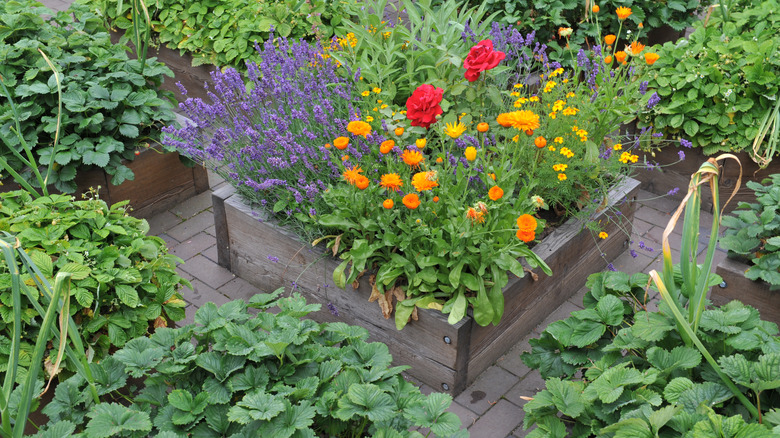Stunning in color, delightful in scent, and known for its therapeutic benefits, lavender is a beloved garden flower. Typically, it’s an ornamental plant that may be harvested for its fragrant buds. Yet, lavender provides many benefits when planted in an edible garden. The potent flower is both repulsive to pests and attractive to helpful insects like bumblebees and butterflies. Incorporating it into your garden is an easy way to reap the benefits of this versatile plant.
Adding lavender to an edible garden is called companion planting. Companion planting is when a gardener places a specific plant near their crop to deter pests and encourage healthy growth. Lavender is a popular companion plant in edible gardens because of its ability to repel aphids and other pests that can damage crops. It’s also a favorite of bees and butterflies who pollinate garden crops. Lavender is typically planted amongst vegetables such as tomatoes, peppers, cucumbers, cabbage, cauliflower, and herbs. Though it is a great companion plant, it is also edible and beloved for its unique flavor. You could garnish meals with it, put it in your tea, or bake a tasty treat that features a hint of this flower.
Pests hate the smell of this fragrant flower

When you’re growing an edible garden, you want to share your crops with loved ones, not pests. Using lavender as a companion plant will ensure you enjoy your bounty instead of surrendering it to the unwelcome insects. Lavender is both a fragrant treat and a natural pest repellent. The natural oils like linalool found in lavender repel insects such as caterpillars, mosquitoes, moths, ticks, and even fleas. Insects are notorious for destroying a crop by feeding on leaves, stems, and fruits, so keeping them out of your garden will better protect your crops.
Additionally, the scent of lavender deters rodents like mice and other small animals from feasting on nearby edible plants as well. Planting lavender around your vegetables, fruits, and herbs is like creating an aromatic border that many critters and pests are unwilling to cross. Companion planting is considered a safer and more humane alternative to using pesticides on your edible plants. If you’re searching for a natural and safe way to keep pests away from homes and gardens, lavender is a great option to consider.
Lavender attracts garden-friendly pollinators
While you want to ward off pests, pollinators like bees and butterflies should be welcomed. These flying insects are attracted to the scent of lavender so they harvest its nectar. As bees and butterflies fly from flower to flower, they collect pollen on their bodies and legs. Then, that pollen falls off when the insect visits a female plant. Pollen is necessary for producing fruit and growing plants, so your edible crops will benefit from these winged visitors. In fact, bees pollinate a majority of U.S. grown crops.
Bringing more pollinators into your yard and garden may be as simple as planting lavender and other flowers the insects prefer. However, natural predators like birds may drive off the little helpers or pick them up for a quick snack. You can encourage more bees and butterflies by making your garden safer for them by adding things like bee hotels, which are similar to birdhouses but are made for these pollinators. Providing a water source will also allow your visitors to take a drink between all of their hard work. Adding lavender and native plants to your edible garden will transform it into a hotspot for pollinators who will in turn help your plants grow.